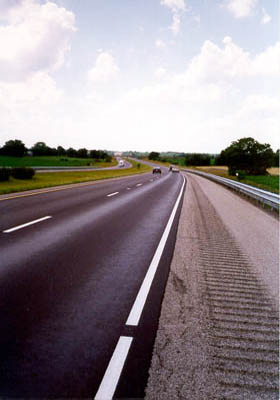U.S. Department of Transportation
Federal Highway Administration
1200 New Jersey Avenue, SE
Washington, DC 20590
202-366-4000
Focus
| Accelerating Infrastructure Innovations |
Publication Number: FHWA-SA-98-020
Date: March 1998
 |
| Soon after opening to traffic, the outside lanes of this Superpave overlay on Interstate 74 began showing signs of flushing. |
Soon after opening to traffic last year, the outside lanes of a newly overlaid section of Interstate 74 in Indiana showed signs of severe flushing. The overlay had been designed using the Superpave mix design system. A team of engineers went to work to figure out what went wrong-and why. They concluded that what happened on I-74 was likely caused by an unusual combination of factors.
The I-74 project involved milling 25 mm (1 in) of asphalt pavement from the surface of all four lanes of a 24-km (15-mi) stretch of the highway near Crawfordsville and replacing it with the same thickness of Superpave mix. The Superpave mix used a PG58-28 binder and a relatively coarse 9.5-mm (3/8 - in) aggregate gradation.
In late June, less than 1 month after opening to traffic, the outside lanes of the project began flushing. This problem, also known as bleeding, occurs when the asphalt binder seeps to the surface of the pavement, usually in the wheelpaths. Flushing can make a pavement slick and can shorten its life.
The flushing on I-74 was severe enough that, within weeks, the Indiana Department of Transportation (DOT) decided to replace the pavement on the outside lanes. As soon as word got out, rumors began circulating that Superpave pavements across the State were failing. "The reaction was 'the sky is falling, the sky is falling,'" says Gerry Huber of Heritage Research Group, who helped to determine the cause of the problem.
Those sentiments went counter to what Indiana DOT knew from firsthand experience. After all, the State had already built more than 60 Superpave pavements, and this was the first time one had to be repaired.
Curiously, the inside lanes, which had been overlaid with an identical mix design several weeks earlier, showed no signs of flushing. What had gone wrong with the outside lanes?
To answer that question, Indiana DOT assembled a team that included the Federal Highway Administration (FHWA) and industry. The team carefully evaluated each step in the construction project, from mix design through field quality control.
Indiana DOT's Dave Andrewski says the investigation found that several factors could have contributed to the flushing on the outside lanes. However, because the inside lanes performed fine the investigation focused on factors other than the mix design. One key finding was that the outside lanes were placed after extremely heavy rain soaked the aggregate stockpiles and the milled surface of the existing pavement. If the aggregates were not adequately dried or if the milled pavement was too wet when the new pavement was placed, the moisture content in the new pavement would have been increased, making it more likely to flush.
The team also found that the mix design did not strictly adhere to the Superpave specifications. Samples of the mix from the asphalt plant were cured for 2 hours before field quality control testing was performed. According to the Superpave specifications, the samples should not have been cured at all. Compared with the mix delivered to the paving site, the samples were stiffer and had less moisture when they were field tested with the Superpave gyratory compactor.
Huber notes two other factors that may have contributed to the flushing. The mix was designed for just under 10 million equivalent single-axle loads (ESALs), based on a design life of 7 years. The short design life was used to match the intended life of the I-74 maintenance project. In addition, the mix used a PG58-28 binder. A mix designed for more than 10 million ESALs would have had a lower asphalt content, and a PG64-22 binder would have been "stiffer" than the binder used on I-74. Both changes would have made the mix less likely to develop flushing. Huber says that coarse graded mixes are more sensitive to stiffness than fine graded mixes.
Andrewski, agreed, saying"If we had used a stiffer binder, maybe we could have bought some insurance."
When the outside lanes of I-74 were re-overlaid, Indiana DOT specified a mix designed for slightly higher traffic loads than the original mix. The new mix used a stiffer PG64-22 binder. To date, the new pavement is performing flawlessly, says Andrewski. Based in part on this experience, Indiana DOT now considers using a stiffer binder grade for all pavements on Interstate highways.
Indiana DOT hasn't let this isolated problem interfere with its statewide conversion to the Superpave system (see sidebar, p. 4). "It took a combination of things to cause this problem," says Andrewski. "It proves that the checks and balances in the Superpave system work-if we violate the specifications, we are likely to have some problems."
For more information, contact Dave Andrewski of Indiana DOT (phone: 317-232-5280; fax: 317-356-9351) or Lee Gallivan at FHWA (phone: 317-226-7493; fax: 317-226-7341; email: victor.gallivan@fhwa.dot.gov).
| INDIANA MAKES SUPERPAVE MIXES STANDARD
The Indiana Department of Transportation (DOT) has made the Superpave system standard for virtually all asphalt pavements constructed in the State. The State's new specification for asphalt pavements, which went into effect in January 1998, calls for Superpave mixes on all but the smallest paving projects. The specification for Superpave mixes was developed in a series of 38 meetings held over a 25-month period. The meetings involved the State highway agency, contractors, suppliers, and FHWA. "There are growing pains," says Dave Andrewski of Indiana DOT. "However, by and large the Superpave specifications have been accepted by industry." The highway agency is now holding a final set of meetings to hammer out the last remaining details and prepare for this year's construction season, when the highway agency plans to build more than 100 Superpave pavements. |